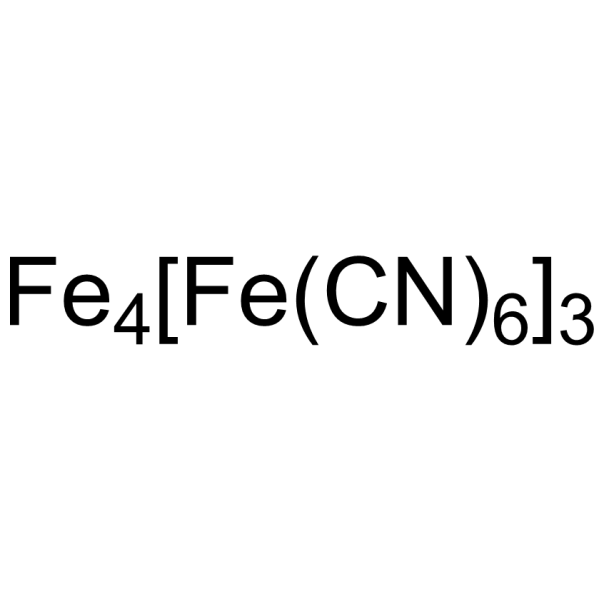14038-43-8
| Name | ferric ferrocyanide |
|---|---|
| Synonyms |
Iron(3+) hexakis(cyano-κC)ferrate(4-) (4:3)
Tetrairon(3+) tris[hexacyanoferrate(4-)] PARIS BLUE EINECS 237-875-5 BERLIN BLUE Miroli Blue Ferrate(4-), hexakis(cyano-κC)-, iron(3+) (3:4) Prussian blue MFCD00135663 Iron(III) Hexacyanoferrate(II) CHINESE BLUE Iron(III) Ferrocyanide |
| Description | Prussian blue insoluble (Iron(III) ferrocyanide) is a good adsorbent to be used as antidotes for poisoning with cesium or thallium ions. Prussian blue insoluble (Iron(III) ferrocyanide) has anticancerous and antibacterial properties. Prussian blue insoluble (Iron(III) ferrocyanide) can be used as a contrast agent in photoacoustic and magnetic resonance imaging (MRI). Prussian blue insoluble can be used for contrast agents, antidotes and cancer research[1][2][3][4]. |
|---|---|
| Related Catalog | |
| In Vitro | Prussian blue insoluble (Iron(III) ferrocyanide) (0.1-3.0μg/mL; 24 hours; HUVECs) has photo-thermal effect and inhibits cell viabilities[1]. Prussian blue insoluble (Iron(III) ferrocyanide) (0.07 mM; 0-24 hours) act as a metabolic indicator, being reduced by bacterial metabolism, producing a visible color change from blue to colorless[2]. Cell Viability Assay[1] Cell Line: HUVECs Concentration: 24 hours Incubation Time: 0.1, 0.2, 0.5, 1.0, 2.0 and 3.0 μg/mL Result: Decreased the cell viabilities as the time of NIR laser irradiation |
| In Vivo | Prussian blue insoluble (3 g/day; p.o.; for 8 days; rats)(Iron(III) ferrocyanide) can be used as a therapeutic agent in radiocesium and thallium poisoning[3]. Animal Model: Rats[3] Dosage: 3 g/day Administration: Oral administration; 8 days Result: Increased excretion of cesium-134. |
| References |
| Density | 1.8 |
|---|---|
| Boiling Point | 25.7ºC at 760 mmHg |
| Molecular Formula | C18Fe7N18 |
| Molecular Weight | 859.228 |
| Exact Mass | 859.599915 |
| PSA | 428.22000 |
| LogP | 0.28454 |
| Vapour Pressure | 740mmHg at 25°C |
| Stability | Stable. Incompatible with strong acids, strong oxidizing agents, ammonia. Light sensitive. |
CHEMICAL IDENTIFICATION
HEALTH HAZARD DATAACUTE TOXICITY DATA
|
| Hazard Codes | Xn,T,F,Xi |
|---|---|
| Risk Phrases | R40:Limited evidence of a carcinogenic effect. R22:Harmful if swallowed. R10:Flammable. R36/38:Irritating to eyes and skin . R23/25:Toxic by inhalation and if swallowed . R11:Highly Flammable. R36/37/38:Irritating to eyes, respiratory system and skin . |
| Safety Phrases | 22-24/25 |
| RIDADR | UN 1993 |
| WGK Germany | 1 |
| RTECS | LJ8200000 |
| HS Code | 29322910 |
|
~% 
14038-43-8 |
| Literature: Journal of the Chemical Society, Dalton Transactions: Inorganic Chemistry (1972-1999), , p. 2059 - 2062 |
| Precursor 2 | |
|---|---|
| DownStream 0 | |
| HS Code | 29322910 |
|---|


